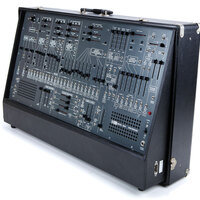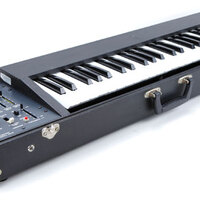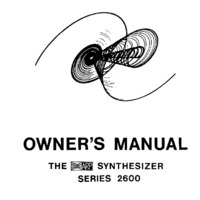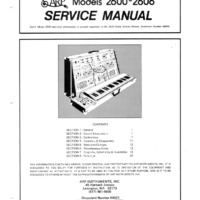ARP 2600P v2
Item
Model
ARP 2600P v2
Make
ARP
Type
Analog Semi-modular Synth
Description
History Overview
The ARP 2600 is a semi-modular analog synthesizer invented by Alan Robert Pearlman. It was manufactured between 1971 to 1980, before ARP went out of business in 1981. The ARP was purposefully made semi-modular with less functions to make it a powerful but cheaper alternative to other synthesizers at the time. At the beginning of the 1970’s, synthesizer companies began to slowly move away from massive modular systems and create more self contained instruments. The 2600 sat in the middle, containing a massive patchable interface but also allowed itself to be played with a keyboard and no patching. It’s production was marked by many issues. This included a lawsuit with Moog over ARP copying their patented filter circuit, which resulted in a new filter design that ended up being faulty. As the decade went on, it was agreed that the quality of the instrument declined gradually. Despite its slightly tumultuous years on the market, it is now regarded as one of the most sought after vintage synthesizers. Approximately 3,000 units were made in it’s runtime, and everyone from Herbie Hancock to Depeche Mode to The Who have sung its’ praise.
The ARP in TIMARA’s possession, based on the case, is the 2600P v.2.0 model made in 1972. The synth also comes with an original 3604P model keyboard. This was one of the last 2600 models made before the line began dropping in quality, and features the original pre-lawsuit Moog style filter. Other than a few scratchy pots and sliders, this ARP is in amazing condition and still sounds incredible.
Principles for Patching
One thing that is worth noting with the ARP is that technically you don’t have to patch anything at all. As a semi-modular synth, it is made with pre-routed connections on the inside that you control through the sliders that are all over the synth. These allow many different things to happen, but they always control the amplitude of a connection. This could be the volume of an oscillator going into a mixer, or the amplitude of a modulation source. The sliders all have labels as to what each one is already routed to, and there will be a label around the top of the sliders to tell you where that signal is going or what it is affecting. These sliders allow for quick and easy routing of audio and voltages.
However, if want to experiment, you can break these pre-routed connections by taking a sound or control voltage output and routing it into a patchable input with an ⅛” cable. For instance, the ARP has 3 oscillators in it. If you want the third oscillator to modulate the frequency of the first oscillator, then you take an output for the third and run it into one of the inputs for frequency modulation on the first oscillator under a slider. Then you bring the slider up to bring attenuate the amount of FM coming from the third oscillator. This can be applied across the board. Between the normalled connections and the patching possibilities, the ARP provides an amazing opportunity for sonic exploration.
Patches:
Startup
Basic synth patch (include explanation of LFO/Audio rate oscillators)
FM Timbres
Play with Filter resonance
Using sample and hold, switch and clock
Oscillator Chords
Bibliography
“ARP 2600.” Vintage Synth Explorer. Accessed December 21, 2017. http://www.vintagesynth.com/arp/arp.php.
The ARP 2600 is a semi-modular analog synthesizer invented by Alan Robert Pearlman. It was manufactured between 1971 to 1980, before ARP went out of business in 1981. The ARP was purposefully made semi-modular with less functions to make it a powerful but cheaper alternative to other synthesizers at the time. At the beginning of the 1970’s, synthesizer companies began to slowly move away from massive modular systems and create more self contained instruments. The 2600 sat in the middle, containing a massive patchable interface but also allowed itself to be played with a keyboard and no patching. It’s production was marked by many issues. This included a lawsuit with Moog over ARP copying their patented filter circuit, which resulted in a new filter design that ended up being faulty. As the decade went on, it was agreed that the quality of the instrument declined gradually. Despite its slightly tumultuous years on the market, it is now regarded as one of the most sought after vintage synthesizers. Approximately 3,000 units were made in it’s runtime, and everyone from Herbie Hancock to Depeche Mode to The Who have sung its’ praise.
The ARP in TIMARA’s possession, based on the case, is the 2600P v.2.0 model made in 1972. The synth also comes with an original 3604P model keyboard. This was one of the last 2600 models made before the line began dropping in quality, and features the original pre-lawsuit Moog style filter. Other than a few scratchy pots and sliders, this ARP is in amazing condition and still sounds incredible.
Principles for Patching
One thing that is worth noting with the ARP is that technically you don’t have to patch anything at all. As a semi-modular synth, it is made with pre-routed connections on the inside that you control through the sliders that are all over the synth. These allow many different things to happen, but they always control the amplitude of a connection. This could be the volume of an oscillator going into a mixer, or the amplitude of a modulation source. The sliders all have labels as to what each one is already routed to, and there will be a label around the top of the sliders to tell you where that signal is going or what it is affecting. These sliders allow for quick and easy routing of audio and voltages.
However, if want to experiment, you can break these pre-routed connections by taking a sound or control voltage output and routing it into a patchable input with an ⅛” cable. For instance, the ARP has 3 oscillators in it. If you want the third oscillator to modulate the frequency of the first oscillator, then you take an output for the third and run it into one of the inputs for frequency modulation on the first oscillator under a slider. Then you bring the slider up to bring attenuate the amount of FM coming from the third oscillator. This can be applied across the board. Between the normalled connections and the patching possibilities, the ARP provides an amazing opportunity for sonic exploration.
Patches:
Startup
Basic synth patch (include explanation of LFO/Audio rate oscillators)
FM Timbres
Play with Filter resonance
Using sample and hold, switch and clock
Oscillator Chords
Bibliography
“ARP 2600.” Vintage Synth Explorer. Accessed December 21, 2017. http://www.vintagesynth.com/arp/arp.php.
Access
Those who have permission to use Studio 4
Location
Studio 4 Synth Table




